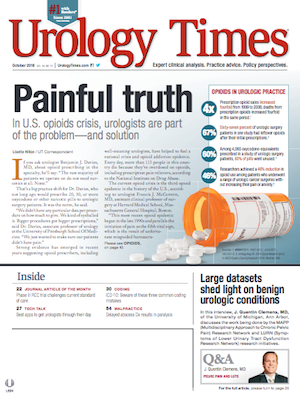Publication
Article
Urology Times Journal
CIC-associated bacteriuria: When to treat-and not treat
Author(s):
Bacteriuria in patients using clean intermittent catheterization is a significant problem that can lead to overuse of antibiotics. J. Quentin Clemens, MD, of the University of Michigan, Ann Arbor, discusses when to treat and when not to treat these patients.
Bacteriuria in patients using clean intermittent catheterization is a significant problem that can lead to overuse of antibiotics. J. Quentin Clemens, MD, of the University of Michigan, Ann Arbor, discusses when to treat and when not to treat these patients. Dr. Clemens was interviewed by Urology Times Editorial Consultant Gopal H. Badlani, MD, professor of urology at Wake Forest Baptist Medical Center, Winston-Salem, NC.
Please briefly discuss the issue of bacteriuria and clean intermittent catheterization.
It’s a huge problem because it leads to over-treatment of patients, and we are becoming more and more aware of the risk of overuse of antibiotics. Patients who use a catheter to empty their bladder will have bacteriuria, and it’s surprising to me how many clinicians don’t seem to be aware of that. Patients need to be their own protectors and not let clinicians treat them with antibiotics if they’re not having bladder-specific symptoms.
The problem, of course, is sometimes the symptoms are non-specific, in which case I recommend getting a urine culture and holding off on treating until the culture results are back and then seeing if the symptoms go away. If they do go away, then they shouldn’t get antibiotics.
Some patients do in fact have recurrent symptomatic UTIs, at which point I recommend checking for structural or functional abnormalities. What does that mean? I have them get a renal/bladder ultrasound to check for kidney stones or bladder stones and potentially urodynamics if they haven’t had that recently.
If all of that looks OK, we’ve had great success using intravesical gentamicin to help prevent UTIs. It can be administered each evening; patients instill 50 or 60 cc and then leave it in overnight and remove it the next morning when they’re catheterized. It does not cause gentamicin resistance and it works very well to reduce UTIs without exposing them to systemic antibodies. I was a co-author of a study of this that was published in the Canadian Urological Association Journal (2017; 11:E350-4).
What dosage is used?
We use 480 mg that is diluted in 1 liter of normal saline. Many pharmacists will tell patients it has to be refrigerated, but it can in fact be stored at room temperature.























